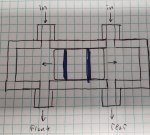7bdiver
Active member
- 92
- 170
- 33
- Location
- idaho panhandle
.
If I remember correctly, the "79ish" Chevrolet pickup trucks have (had?) a proportioning valve in the brake system just below the master cylinder. There is a "rubber button" on the front of it and if the front or rear brake lines exploded, the functional part of the brake system would still be operational.
It's fuzzy, but I remember learning that the hard way repairing a truck. Easily found the busted rubber line, but I couldn't figure out how to bleed the brakes. Fluid wouldn't pass to the back axle. Problem was solved when one of the older guys pointed out the "button" on that valve - and PRESTO - fluid flowed again...
I looked at how the proportioning valves you were talking about worked. The ones with the reset. They're a combination valve. These would actually do the same thing as i was trying to achieve, and they're fairly cheap. They also have a warning light sender already on them to tell you when one circuit fails.
If you get the combination style proportioning valve, the center piston inside will shut off the leg that lost pressure in the event of back pressure loss. These are normally mounted right under your master cylinder on most vehicles. Very common on-the-shelf part.
So, put a T-splitter at your main outlet, run the two lines to your proportioning valve inputs. Now you have separate outputs from the valve to your front and rear.
They usually have two front outputs, just use one, plug the other. Presto, you have dual circuit brakes for like 35-50 bucks!
Might need to find one big enough for a deuce. I'm not sure how much adjustment they have. I assume a standard one would think your slamming on the brakes at all times.
Whew! No need to machine one from scratch.
I'll take some time to find one big enough and with the right size fittings already on it.









